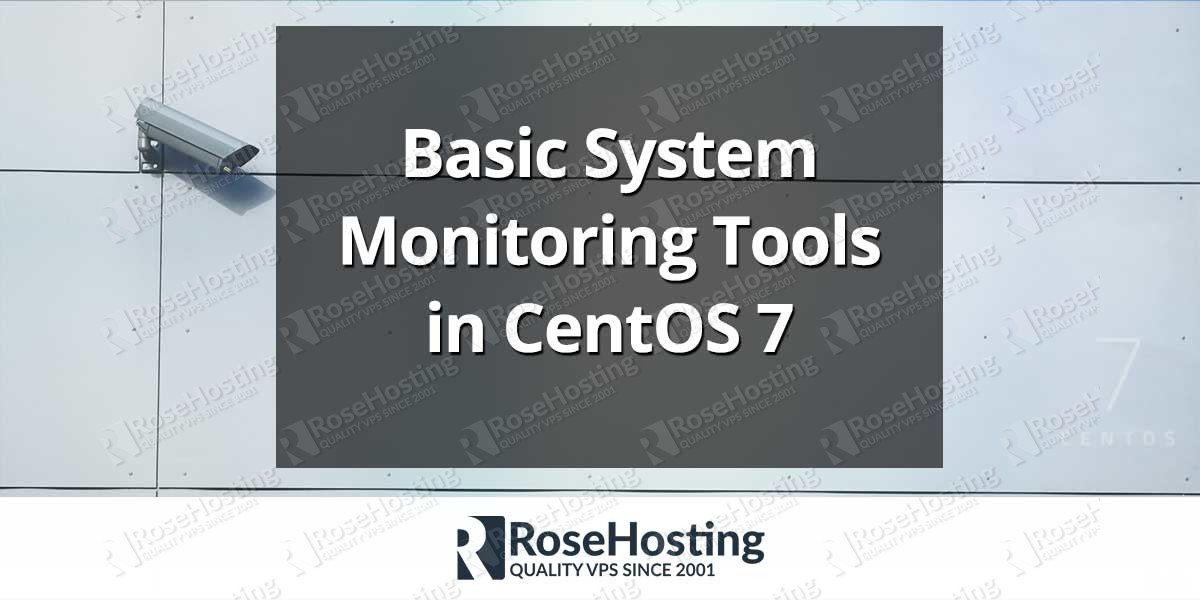In this post, we are going to show you how to use the basic system monitoring tools on a Linux VPS running CentOS 7 as operating system.
Determining which processes are running, the amount of free memory on your system as well as the free SSD storage available to use is crucial when configuring the system. One of the basic system monitoring tools which is available on all Linux systems is ps. The ps command will report a snapshot of the current processes running on your CentOS VPS and will display information about a selection of active processes. The ps command has many different options which can be mixed. In many situations, ps aux will provide you with all the information you need.
# ps aux
The output of the command will provide you with information such as the process owner, ID of the process, CPU and memory usage, the time or date when the process was started, etc. The output should be similar to the one below:
# ps aux USER PID %CPU %MEM VSZ RSS TTY STAT START TIME COMMAND root 1 0.5 0.2 41220 3660 ? Ss 08:53 0:00 init -z root 2 0.0 0.0 0 0 ? S 08:53 0:00 [kthreadd] root 3 0.0 0.0 0 0 ? S 08:53 0:00 [khelper] root 65 0.0 0.1 36768 1820 ? Ss 08:53 0:00 /usr/lib/systemd/systemd-journald root 73 0.0 0.1 41600 1700 ? Ss 08:53 0:00 /usr/lib/systemd/systemd-udevd root 103 0.0 0.0 24224 1536 ? Ss 08:53 0:00 /usr/lib/systemd/systemd-logind root 109 0.0 0.1 293512 2608 ? Ssl 08:53 0:00 /usr/sbin/rsyslogd -n dbus 112 0.0 0.1 26548 1680 ? Ss 08:53 0:00 /bin/dbus-daemon --system --address=systemd: --nofork --nopidfile --systemd-activation root 137 0.0 0.2 82504 3576 ? Ss 08:53 0:00 /usr/sbin/sshd -D ...
For more usage examples and options visit the man page:
# man ps
The next useful tool for system monitoring is top. Similarly to ps, top displays the Linux processes running on your server in real-time but the output is dynamic. Run top to check the output:
# top
top - 09:01:41 up 8 min, 0 users, load average: 0.00, 0.00, 0.00
Tasks: 32 total, 1 running, 31 sleeping, 0 stopped, 0 zombie
%Cpu(s): 0.2 us, 0.0 sy, 0.0 ni, 99.8 id, 0.0 wa, 0.0 hi, 0.0 si, 0.0 st
KiB Mem : 1572864 total, 1318572 free, 28772 used, 225520 buff/cache
KiB Swap: 0 total, 0 free, 0 used. 1331552 avail Mem
PID USER PR NI VIRT RES SHR S %CPU %MEM TIME+ COMMAND
718 root 20 0 155404 2144 1540 R 0.3 0.1 0:00.05 top
1 root 20 0 41220 3660 2276 S 0.0 0.2 0:00.25 systemd
2 root 20 0 0 0 0 S 0.0 0.0 0:00.00 kthreadd
3 root 20 0 0 0 0 S 0.0 0.0 0:00.00 khelper
65 root 20 0 36768 1820 1540 S 0.0 0.1 0:00.02 systemd-journal
73 root 20 0 41600 1700 1272 S 0.0 0.1 0:00.00 systemd-udevd
103 root 20 0 24224 1540 1292 S 0.0 0.1 0:00.00 systemd-logind
109 root 20 0 293512 2608 2008 S 0.0 0.2 0:00.00 rsyslogd
To terminate the utility, enter q. To sort the list by memory or CPU usage, enter M or P respectively. The man page of top will provide you with additional information about the usage.
# man top
To determine the memory usage, run the following command:
# free -m
The free command will display amount of free and used memory in the system in megabytes. It will provide you with information about the total amount of memory, the amount of memory which is used, free, shared, cached and available. The free command will provide you with information about the swap space too.
# free -m
total used free shared buff/cache available
Mem: 1536 31 1282 136 221 1296
Swap: 0 0 0
Visit the man page for more information and usage options:
# man free
Next, the df command will display a report of the file system disk space usage. To view the information in human readable format, run:
# df -h
The output should look like the one below:
# df -h Filesystem Size Used Avail Use% Mounted on /dev/simfs 30G 1.9G 29G 7% / devtmpfs 768M 0 768M 0% /dev tmpfs 768M 0 768M 0% /dev/shm tmpfs 768M 8.1M 760M 2% /run tmpfs 768M 0 768M 0% /sys/fs/cgroup
The man page will provide you with additional information about the usage.
# man df
The last tool we are going to write about is du. This command will display an estimate file space usage. For example, to display the total space usage of the /home directory, you can use the following command:
# du -sxch /home/
Sample output:
# du -sxch /home/ 391M /home/ 391M total
To learn more about the du command and the other usage options, visit the man page:
# man du
Of course you don’t have to do any of this if you use one of our CentOS 7 VPS hosting services, in which case you can simply ask our expert Linux admins to help you determine the resource usage on your server. They are available 24×7 and will take care of your request immediately.
PS. If you liked this post please share it with your friends on the social networks using the buttons on the left or simply leave a reply below. Thanks.
